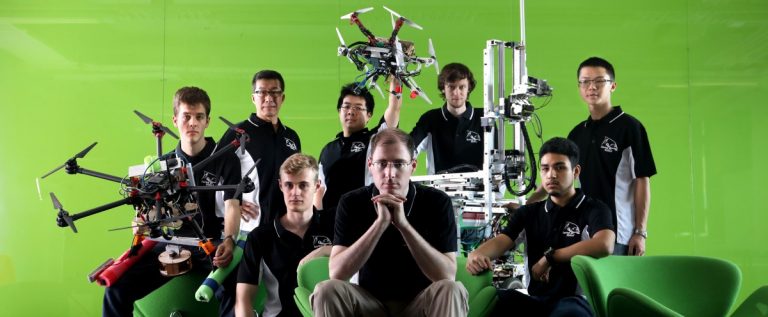
A 10-member crew and their five robot creations representing the University of New South Wales (UNSW) will be taking on 24 other teams from 11 countries at the 2017 Mohamed Bin Zayed International Robotics Competition (MBZIRC) this weekend.
Up for grabs is a massive US$5 million grand prize and the UNSW team is the only Australian school to qualify for what is said to be the richest robotics competition in the world, named after the crown prince of Abu Dhabi, Mohamed Zayed.
The challenge will focus on disaster response and how robots react to “ambitious and technologically demanding” set of tests, such as communication, according to the team’s lead researcher Dr Mark Whitty.
“From 9/11 on, there have been problems. We need systems that don’t rely on cables or uncertain WiFi and other systems,” Whitty told Sydney Morning Herald.

Whitty poses with Pepper. Source: UNSW
The team comprises three researchers and four students who developed an unmanned ground vehicle (UGV) they named Pepper and four hexacopter drones (Flippy, Floppy, Flappy and Fally) alongside three graduate students now working at Uber, Microsoft and Google.
The UGV and drones would be tested for their “dexterity and mobility”, said project leader Stanley Lam, a UNSW research associate and recent postgraduate student.
“Our robot drones are going to be put to the test, identifying objects from the air, landing on moving vehicles to pick up those objects, then delivering them to a target site.
“… the UGV has to drive to a panel in a location, identify and pick up a certain size spanner, grip it, and use it to turn a valve stem – all of this without human intervention,” he said.

Pepper can go up to 11km per hour, while the drones can fly at 60km/h, twice the competition’s speed limit.
Research into real-life applications
International competitions like this allow students to translate their research into the real world and in the process, “the development of robotics for search and rescue and disaster response will be accelerated”, according to UNSW’s Dean of Engineering Mark Hoffman.
“Such competitions play a key role in advancing knowledge,” Hoffman said, adding UNSW and Australia are top leaders in robotics and artificial intelligence.
A total of 143 teams from 35 countries had joined the challenge, but only 25 from 12 countries qualified.
Other teams who made it through are Carnegie Mellon University (US), ETH Zurich (Switzerland), University of Tokyo (Japan) and Imperial College London (UK).
The competition will take place at the Yas Marina Circuit on Yas Island, off the coast of Abu Dhabi where the annual Formula One Grand Prix is hosted.







